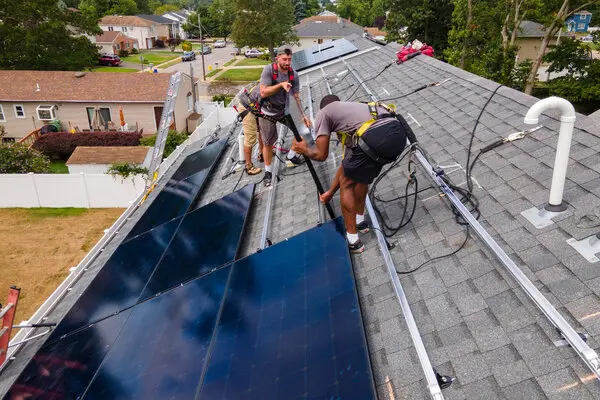Are you considering upgrading your HVAC system but feeling overwhelmed by the costs? Worry no more! The U.S. government and utility companies offer a variety of rebates and incentives aimed at making energy-efficient appliances, including heating and air conditioning systems, more affordable for homeowners like you.
In this blog post, we will guide you through the process of understanding HVAC rebates, finding available incentives in your area, ensuring eligibility requirements are met, and maximizing these opportunities to save on high-efficiency equipment—all while improving your home comfort and reducing your carbon footprint.
If you’re looking for a company that can help you take advantage of HVAC rebates, you can contact the team at IMS.
Table of Contents
Understanding HVAC Rebates
HVAC rebates in the U.S. come in various forms, including federal and state tax credits, incentive programs for energy-efficient appliances, and government rebates for air conditioning and heating upgrades.
Federal And State Tax Credits
Both federal and state tax credits play a crucial role in helping homeowners save money on their energy-efficient upgrades, including HVAC systems. By encouraging property owners to invest in high-efficiency equipment, these tax credits contribute to significant savings while promoting the use of clean energy technologies.
State-level rebates can vary depending on individual state legislation and policies. For example, some states may offer additional incentives for heating and cooling equipment that meets specific criteria relating to energy usage or overall performance.
It is essential for homeowners seeking to benefit from these financial incentives to research their state’s rebate programs thoroughly before committing to any HVAC upgrade.
Incentive Programs For Energy-Efficient Appliances
In addition to federal and state tax credits, there are also incentive programs available for energy-efficient appliances. These programs provide rebates to customers who purchase products that meet certain energy efficiency standards.
Examples of these products include Energy Star certified refrigerators, dishwashers, and washing machines. In some cases, rebate amounts can range from a few hundred dollars up to thousands of dollars depending on the product’s level of energy efficiency.
Government Rebates For Air Conditioning And Heating
Government rebate programs are available for homeowners who want to upgrade their air conditioning and heating systems. These rebates can significantly reduce the upfront cost of purchasing and installing new, energy-efficient equipment.
To take advantage of these programs, it’s crucial to research available rebates thoroughly and make sure that eligibility requirements are met before purchasing any HVAC equipment.
Additionally, it’s essential to select energy-efficient products that meet or exceed industry standards like Energy Star certification to maximize savings on utility bills over time.
How To Maximize HVAC Rebates
To maximize HVAC rebates, start by researching available programs and ensuring that you meet the eligibility requirements; then choose energy-efficient equipment, such as Energy Star certified products or high-efficiency electric units, and submit your rebate application accurately.
Research Available Rebates
Before starting any home improvement project, it’s important to research the available HVAC rebates in your area. This involves checking federal and state tax credits, incentive programs for energy-efficient appliances, and government rebates for air conditioning and heating.
The easiest way to do this is by visiting the Energy Star website, which provides a comprehensive list of rebate programs that apply nationwide. Additionally, many local utility companies offer their own rebate programs for customers who invest in energy-efficient HVAC systems.
Ensure Eligibility Requirements Are Met
Before submitting an application for HVAC rebates, it’s crucial to make sure you meet all eligibility requirements. These can vary depending on the program, but commonly include income limits, location restrictions or proof of purchase.
It’s also vital to choose equipment that meets the required standards for energy efficiency and clean energy technology in order to qualify for many government incentive programs like federal tax credits or state rebates.
Make sure that you educate yourself about what qualifies as Energy Star certified products so that your investment will pay off with maximum savings over time.
Choose Energy-efficient Equipment
One of the most crucial steps to maximize HVAC rebates is selecting energy-efficient equipment. This means choosing an HVAC system that meets or exceeds the Energy Star standards and has a high Seasonal Energy Efficiency Ratio (SEER) rating.
For heat pumps, look for those with the highest Heating Seasonal Performance Factor (HSPF) rating.
Moreover, investing in clean energy technology like solar thermal panels or geothermal systems can qualify you for additional state or federal tax credits and incentives.
Before making any purchases, always research available options carefully and compare prices to ensure you’re getting the best deal while meeting eligibility requirements.
Submit Rebate Application Accurately
Submitting your HVAC rebate application accurately is crucial to ensure that you receive the maximum benefit possible.
Make sure you have followed all of the instructions provided by the rebate program and included any necessary documentation, such as proof of purchase or installation. Be sure to include accurate details about the equipment and its energy efficiency ratings.
For example, if you’re applying for an air conditioner rebate, make sure you provide relevant details like model number, tonnage capacity and seer rating.
By taking these steps and ensuring that every detail is correct, you can improve your chances of receiving significant discounts from government incentives programs across the US for energy-efficient appliances and HVAC systems while promoting sustainable living practices at home or work!
How To Benefit From HVAC Rebates In The U.S. — Conclusion
By understanding and maximizing HVAC rebates, you can save money while making your home more energy-efficient. Research available rebates and ensure that you meet eligibility requirements before choosing high-efficiency equipment that qualifies for government incentives.
By submitting your rebate application accurately, you can enjoy the benefits of clean energy technology, sustainable living, and utility rebates. Taking advantage of federal tax credits and state rebates for home energy improvements is an excellent way to upgrade your heating and cooling systems with renewable energy sources such as heat pumps.
















